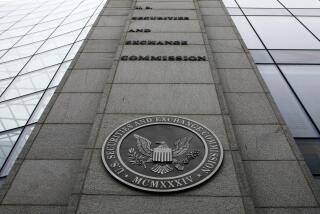RTC Cleared in Handling of S&L; Failures in Texas : Banking: But Justice Dept. says staff changes and frequent transfers of cases between attorneys has disrupted operation.
- Share via
WASHINGTON — A Treasury Department probe into S&L; cleanups in Texas concluded that while there was no “wide-ranging failure” to pursue S&L; officials, the government is unlikely to recover much money from them.
Texas accounted for more than 40% of the nation’s thrift failures, and current and former Resolution Trust Corp. officials there have been harshly critical of the agency’s ability to recoup taxpayer-backed losses, particularly from S&L; officials.
Few S&L; officials there have had their personal financial records subpoenaed, even though RTC figures show that 57% of suspected insider fraud cases were centered in Texas.
According to estimates by the General Accounting Office, the investigative arm of Congress, losses in Texas could cost taxpayers up to $150 billion.
The investigation was prompted in part by testimony before the Senate Banking Committee last fall in which Thomas Burnside, a former RTC attorney in Dallas, said that the failure to file subpoenas against most S&L; officials hurt the agency’s ability to recover money from S&L; insiders.
“There was not a wide-ranging failure to pursue professional liability claims in Texas,” the Treasury Department’s report concluded. “Dallas . . . attorneys and investigators generally believe that professional liability cases are adequately investigated, and not closed merely because the statute of limitations is about to expire.”
However, the report also noted that controversial staff changes and the frequent transfers of cases from one attorney to another “have been extremely disruptive to the operation of the program.”
The report also slammed “inadequate management of personnel in Dallas and inadequate oversight by the RTC in Washington.”
The major controversy, however, centered on the agency’s failure to subpoena records from S&L; officers and board members in cases where looting may have occurred.
Burnside and other critics have insisted that in order to adequately prepare a case--and to find out if looting took place--it was important to subpoena these people.
The Associated Press reported in January that in 99 of 122 cases investigated through early 1993, no subpoenas were issued against S&L; insiders.
Recoveries from insiders, to date, total about $11 million.
The Treasury Department report insists, however, that issuing subpoenas against insiders is unnecessary.
“The vast majority of civil cases investigated in America do not rely on pre-complaint administrative subpoenas because only a few government agencies and no private litigants have this authority,” the report stated. “For the majority of RTC cases handled before 1992, administrative subpoenas were not used as an investigative tool to determine whether to file a lawsuit” against an S&L; director or officer.
However, the RTC expressly asked for--and received--the power to issue administrative subpoenas, making it one of “only a few government agencies” with this authority.
And while the RTC automatically gains access to the failed S&L;’s records, administrative subpoenas are needed to delve into the private financial matters of S&L; officials who may have defrauded the thrift.
The Treasury report maintained that once a suit is filed, government attorneys can then pursue those individuals--an approach Burnside equated with firing a gun while blindfolded.
More to Read
Sign up for Essential California
The most important California stories and recommendations in your inbox every morning.
You may occasionally receive promotional content from the Los Angeles Times.













